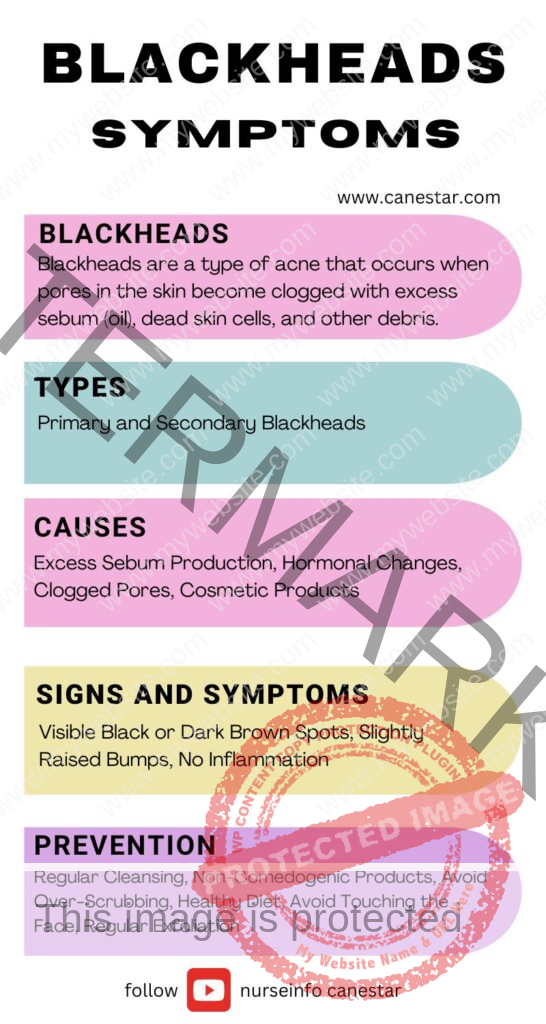BLACKHEADS SYMPTOMS – Definition, types, causes, signs and symptoms, diagnosis, treatment and prevention
BLACKHEADS SYMPTOMS – Definition, types, causes, signs and symptoms, diagnosis, treatment and prevention
Blackheads: Overview
Definition:
Blackheads are a type of acne that occurs when pores in the skin become clogged with excess sebum (oil), dead skin cells, and other debris. Unlike whiteheads, blackheads have an open surface, which allows oxidation to turn the clogged material black or dark brown.
Types of Blackheads:
- Primary Blackheads: These are common blackheads that appear due to clogged pores.
- Secondary Blackheads: These form from pre-existing acne or pimples that turn into blackheads over time.
Causes:
- Excess Sebum Production: Overactive sebaceous glands produce more oil than needed.
- Hormonal Changes: Puberty, menstruation, pregnancy, and use of birth control pills can increase hormone levels, leading to increased oil production.
- Clogged Pores: Accumulation of dead skin cells, dirt, and bacteria.
- Cosmetic Products: Use of comedogenic (pore-clogging) makeup or skincare products.
- Diet: High intake of dairy products and high glycemic foods.
- Sweating: Excessive sweating, especially when not cleaned off, can contribute to clogged pores.
- Certain Medications: Drugs that contain corticosteroids, lithium, or androgens can promote blackhead formation.
Signs and Symptoms:
- Visible Black or Dark Brown Spots: Typically on the face, especially the nose, chin, and forehead, but can also appear on the back, chest, neck, arms, and shoulders.
- Slightly Raised Bumps: The texture may be rough.
- No Inflammation: Blackheads are non-inflammatory lesions, meaning they do not cause redness or swelling unless infected.
Diagnosis:
- Physical Examination: Dermatologists can diagnose blackheads by examining the skin visually.
- Dermatoscopy: A non-invasive skin imaging technique can help in a more detailed examination if needed.
Treatment:
- Topical Retinoids: These help to unclog pores and prevent the formation of blackheads.
- Examples: Tretinoin, Adapalene.
- Salicylic Acid: A beta-hydroxy acid (BHA) that exfoliates the skin and helps clear out clogged pores.
- Benzoyl Peroxide: Helps reduce bacteria and excess oil production.
- Chemical Peels: Glycolic acid or salicylic acid peels can exfoliate the skin to remove dead cells and prevent pore blockage.
- Extraction: Manual removal by a dermatologist using special tools.
- Laser and Light Therapy: Can help reduce oil production or kill bacteria.
Prevention:
- Regular Cleansing: Wash the face twice daily with a gentle cleanser to remove excess oil and dirt.
- Non-Comedogenic Products: Use skincare and makeup products labeled as non-comedogenic.
- Avoid Over-Scrubbing: This can irritate the skin and increase oil production.
- Healthy Diet: Maintain a balanced diet low in dairy and high glycemic index foods.
- Avoid Touching the Face: Reduces the transfer of dirt and bacteria to the skin.
- Regular Exfoliation: Use gentle exfoliants to remove dead skin cells.
By maintaining a consistent skincare routine and addressing the underlying causes, blackheads can be managed and prevented effectively.

Disclaimer: This information is given for educational purpose. This information is provided for educational and informational purposes only and does not constitute providing medical advice or professional services. The information provided should not be used for diagnosing or treating a health problem or disease, and those seeking personal medical advice should consult with a licensed physician. Always seek the advice of your doctor or other qualified health provider regarding a medical condition.

